Werner Dahlin–Tanner and Ljungby Businessman
“ Your brother Werner is happy and well and is really a swell fellow. He sends you his love and wants you to come soon” Note on post card to Mr & Mrs. Carl Dahlin 146 Culbert St, Dated October, 28, 1948 . Card is from a cousin who was visiting Werner in Ljungby, Sweden at the time.
Carl left Sweden in 1910 for Jamestown New
York and never returned. When this card arrived, Carl had not seen his
older brother in almost 40 years and he had provided little or no information
about his Swedish family.
This little narrative about Werner is an attempt to provide some insight
about Werner. It includes some personal accounts from several people who
either met Werner or had some close association with him.
Information about these people including a family tree showing relationships
of these folks follows 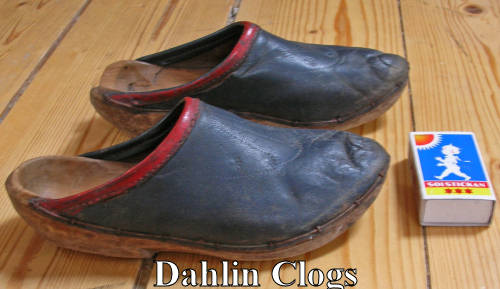
Some historical information, including photographs, about Werner and his
family is also provided. Finally a separate section about the old tannery
that Werner inherited from his father and operated for fifty years is
provided.
Werner’s father bought the tannery in 1891. Erik’s oldest
son Gustaf died in 1890 making Werner, the next oldest son, the natural
heir to the business. Werner took over the tannery in 1905 and gradually
changed the business into the manufacture and sale of Swedish “clogs”
[ Wooden shoes with leather tops]Photo is of clogs that Werner gave to
Gunnar’s grandson Bengt Blix ,when Bengt was about age 8.
Recollections of Jim Huntley
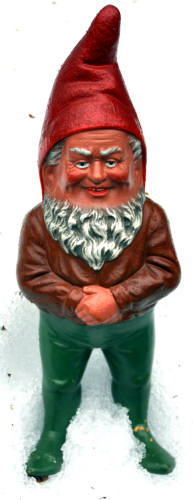 In
October 1948, my first wife Pat and I trundled into Ljungby on our bicycles
from Gothenburg. It was a rainy night and a lousy graveled road but we
made it
In
October 1948, my first wife Pat and I trundled into Ljungby on our bicycles
from Gothenburg. It was a rainy night and a lousy graveled road but we
made it 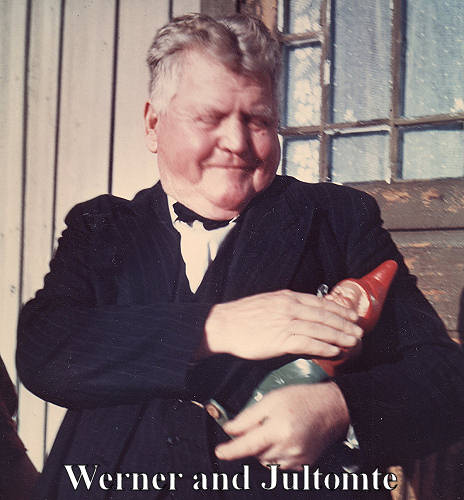 to
Werner's house (I had written ahead) and several relatives were waiting
to greet us. The men all had on formal suits (wing collars, like tuxedos]
and the ladies looked spiffy. Pat and I looked like two drowned rats,
in our yellow sealskin raingear and bare legs. But everyone was jolly;
we got warmed up, and had a big smargasbord. I think we stayed a night
or two with Werner and then we went over to the home of lnga Lisa's mother
and dad, the Blomqvists.
to
Werner's house (I had written ahead) and several relatives were waiting
to greet us. The men all had on formal suits (wing collars, like tuxedos]
and the ladies looked spiffy. Pat and I looked like two drowned rats,
in our yellow sealskin raingear and bare legs. But everyone was jolly;
we got warmed up, and had a big smargasbord. I think we stayed a night
or two with Werner and then we went over to the home of lnga Lisa's mother
and dad, the Blomqvists.
`Werners house at that time had a sizeable lawn with trees and flowers
around. I'd say he had about an acre of living space. And I THINK, but
am not sure, that the Tannery was only a few steps away, on the next lot.
Werner was a real old character, fat and pudgy and then about 75,1 should
judge. He still messed around with his tannery, I think, but mainly a
few men were doing the work and he just checked in now and then. Your
Uncle, the clockmaker Gunnar was also there, and a quiet but very nice
old man.
One funny thing that struck me at Werner's house was that he had about
50 little statues of Juletömte, the Swedish Santa Claus dwarf, that
were scattered around the living and dining rooms. As tactfully as I could,
I asked Werner, "Why have you got all these little fellows here?"
He replied, "Oh they make me laugh!”
When Werner asked about his brother Carl, I told him he lived in Syracuse.
Werner responded with a big belly laugh. “ Carl lives in a Circus!”
The Swedish name for circus is” Sircuse”.
The Juletömte statue shown is one of Werner’s that is currently
owned by his granddaughter Ann-Mari Dahlin.
Recollections of Gustaf and Inga Lisa Erikson
During World War II the Crown Prince of Sweden [FutureKing] was hunting
in the Ljungby area. The Prince’s chauffer stopped in Ljungby to
get gas for the limousine. The Prince became enchanted with the tannery
because of its antique appearance and its smell. He went into Werner's
shop and began to visit. Werner not knowing that he was talking to the
Crown Prince, good-naturedly opened a beer and offered his visitor a drink.
The Prince and him finished the one beer from the same bottle together.
No glass. After the Prince left, the townspeople ran over to Werner and
were flabbergasted to find out that he did not know that he was visiting
with the Crown Prince.
According to Gustaf the store where Werner sold his clogs had a pool table
in it and Werner was a pretty decent pool player. Werner had a journeyman
and a couple of apprentices who did all the work.
Inga Lisa and Gustaf indicated that Werner had bought, under speculation,
a good amount of leather from outside the area before WWII. Because of
the great demand for leather during the war he made a handsome profit.
Gustaf indicated he was a good friend of Werner and often played checkers
with him. He also said, during the war Werner bought a beautiful mahogany
boat in Stockholm that he and Werner often fished in. It was the largest
boat on Lake Bolmen at that time.
. Inga Lisa who knew Werner from her childhood, indicated he had a beautiful
singing voice and at Christmas time when Christmas carols were sung, tears
would come to his eyes. She also said he was a jolly individual that loved
children.
The Erikson’s also indicated that at one point Werner planned to
expand his business, Werner went to Germany to learn how to make beer;
however, this did not pay off
Gustaf indicated that Werner was probably over six foot and when he was
young, very strong. He said he was built like an oak tree. He told the
story that during the war he and Werner were out riding bicycles. They
came to a steep hill and Werner was going very fast down a steep hill
and crashed. Gustaf was sure he was killed but Werner merely shook himself
off and acted like nothing had happened.
Ragnar Bengtsson - Lungby Historian
Translated from a 2007 letter.
I remember very well Dahlin’s tannery in Ljungby from my youth and
it is still well preserved on Ljungby’s Old Market Place as a museum.
I am now 78 years old and have been an active spare time hunter and fisherman
for my whole life. I still remember the first badger I shot as a very
young hunter. I brought the hide for tanning to Dahlin’s tannery
in Ljungby and used it as a desk carpet for many years. It was really
good quality and a testimony of the work that the Dahlin’s made.
Werner’s Youth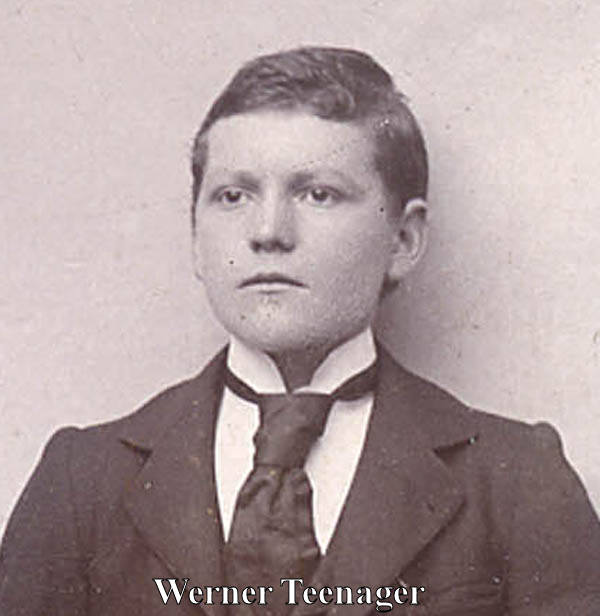
Werner Georg Dahlin was born 27th April 1878 in the Parish of Nöttja.
Little is known about his youth. However, it can be easily assumed that
he took an active role in the tannery after his stepbrother Gustaf died
in 1890. It can also be assume that he attended primary school in Ljungby
and served some time in the Swedish military that was mandated by all
young males at the time
One story from Werner’s youth that came from Werner’s niece
Ingrid Dahlin Blixt is worth repeating. Both Werner and his younger brother
were strong men over six feet tall and were not to be trifled with. Gunnar’s
obituary mentioned that he was well known long distant runner when he
was young. Gunnar told his daughter Ingrid the following story:
“ If people were causing trouble or there was fighting at restaurants,
bars, dancing places or in the a Ljungby market, the police called in
the ‘Dahlin Boys’ [Werner and Gunnar] to help calm the people
down.”
Werner’s Family
Werner’s married Hulda Sofia Lorentz born 2nd of February 1868 in
the parish of Madesjö. According to the household examination records
for the parish of Ljungby for the years 1913-1927 they were living at
the address Tomt 14 D . This may have been the address of the
old Dahlin home and tannery
Before she was married, Hulda owned and operated a small merry-go- round
that she took to various towns in the area. It was not operated by electricity;
instead movement was by man- power. It had a centered cylinder probably
made of fabric and was supported by a steel frame. Ingrid Dahlin Blixt
remembered that a nicely painted tagest [Sign?] that was part of Hulda’s
amusement park was located in the tannery loft.
Werner and Hulda had a favorite pet, a St. Bernard. When the dog 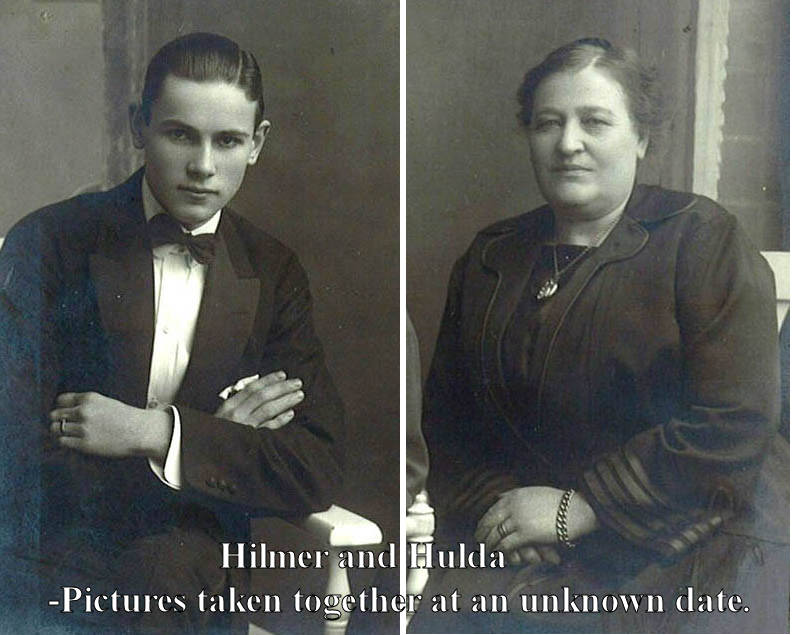 died
Werner tanned the dog’s hide and kept on the floor of his living
area.
died
Werner tanned the dog’s hide and kept on the floor of his living
area.
Werner and Hulda had a reportedly adopted son Hilmer that was born December
27,1905. According to Werner’s granddaughter, Ann-Marie Dahlin,
Hilmer came from a children’s home in Stockholm when he was about
a year old. Ann Marie felt that Hilmer knew who is mother was but not
his father. In any event
Hilmer was very fond of Hulda and thought of her as his mother. It remains
unclear if Hilmer was formally adopted but in any event he maintained
the Dahlin family name that was passed to his two children, Anders and
Ann- Marie and his grandchildren.
Werner Final years 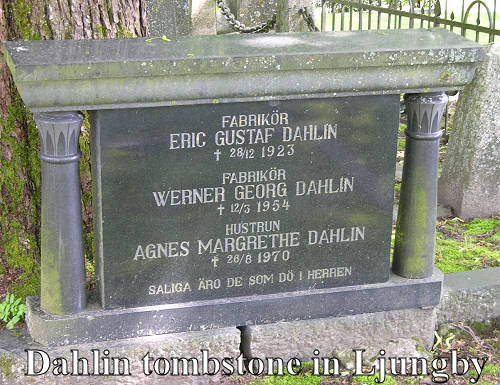
Hulda died at an unknown date. In his later years Werner hired a Norwegian
housekeeper Agnes Margrethe [Jörgensen], born in 1900, who he later
married.
Jim Huntley when visiting Werner in 1948 described Agnes as follows: "
The chubby little Norwegian (probably in her late 40s) was as cute as
a button, kept a clean house, cooked very well, and seemed jolly.’’
Werner died in December 3, 1954. He drowned while he was fishing alone in his boat. His will left the Dahlin home and tannery to Ljungby. The old house was destroyed but the tannery was moved and rebuilt and is now part of the Ljungby old Market Place museum complex
Agnes died in died in 1970. She was buried
in the Ljungby cemetery next to Werner and Werner’s father Eric.
The four Carl Dahlin children received a small amount of money from Agnes
Dahlin’s estate and pooled it together for an “ inheritance
party” at a brother’s home.